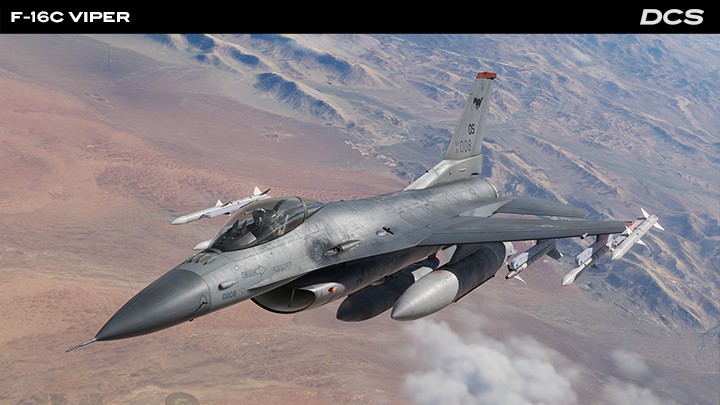F-16C Viper
Development Report

F-16C INS+GPS System Overview
The navigation system on the DCS: F-16C Viper is a complicated mixture of technical solutions that are intended to supply the avionics with coordinates, velocity, and angles, that are characterised by precision, availability, integrity and autonomy. This is achieved by the cooperative work of the Inertial Navigation System (INS) and Global Positioning System (GPS) whose navigation inputs are processed through a Kalman filter in the Modular Mission Computer (MMC). Let’s discuss each of the components in detail.
INS
The Inertial Navigation System is an autonomous device that performs dead reckoning of aircraft coordinates by measuring the accelerations and then integrating them twice whilst taking into account the aircraft’s orientation in space. The latter is obtained from the F-16 ring-laser gyros. This type of INS is termed “strapdown” as there are no rotating parts. Basically, INS consists of three accelerometers, each for one orthogonal axis, and three gyros.
The main features of INS improvements are:
- Autonomy, as it doesn’t require any external signals to do dead reckoning.
- Stability in a short period of time (5-10 minutes).
- Noticeable error accumulation over longer periods of time based on the physics of dead reckoning. Together with the integration of accelerations (to update speed) and integration of position (to update coordinates), the small errors at the level of accelerations that are introduced by accelerometer noises and imperfect alignment are integrated twice as well.
Furthermore, the larger those errors are, the faster they accumulate due to the so-called integral correction of INS, which updates the local Earth gravitational force vector with the coordinates and adds them into the relative angles of the G vector.
Another distinctive feature of INS is the Schuler Oscillation with a period of 84.4 minutes. Due to the integral correction algorithm mentioned above, the INS behaves like a pendulum. In ideal circumstances, it stays in equilibrium while the aircraft moves along the Earth. When coordinate errors appear, it displaces the pendulum from the resting point and it starts oscillating. The larger the errors are, the larger the amplitude of the introduced oscillations. That’s why one may notice that INS errors get smaller at a rate of 84.4 minutes once airborne.
GPS
Global positioning system measures the aircraft position by measuring the signal propagation delay from GPS satellites to the receiver. Satellite orbits are precisely known, the exact positions of the satellites are computed according to an almanack that is transmitted in the same GPS radio signals. That’s why GPS needs a couple of minutes after the cold to start obtaining the almanack. The moments of the signal transmission are also known and are defined by a very precise atomic clock on board the satellite. Thus, in an ideal case, if the GPS signals are propagated through space with the constant speed of light, as they do in a vacuum, the receiver could precisely determine its position by intersecting the surfaces of equidistant radio signal delays from the satellites. You may think of it as spheres with centres located at the satellite’s positions, although it’s a bit more complicated in real life. However, there are two significant factors that prevent us from obtaining the ideal point of the surface intersections; the ionospheric delay and multipath. Both add unknown time to the actual signal propagation time. Multipath happens when the receiver is placed relatively near the ground and the signal may be reflected from ground objects that results in the signal's edges degrading; this is similar to an echo in the mountains where it’s too hard to tell one word from another. When such delays are unexpectedly added by the receiver, the precise navigation solution gets lost and the output
coordinate gets noisy. That’s where military GPS signals help to get a better signal resolution by the use of so-called P-codes, and the usage of dual frequency helps to eliminate the unknown ionospheric delay.
Integrated solution. Kalman filtering
To summarise the above: we have two navigation systems, both of which have flaws: INS accumulates errors over time, GPS is noisy and prone to interference due to natural factors like multipath and ionospheric delay and to enemy jamming and spoofing. Here is the good news! There is a way to avoid these flaws with the Kalman filter. It takes GPS and INS coordinates together with speeds as its input. The Kalman filter is a great algorithm that is able to get the maximum precision even out of measurements far from ideal, and it takes the best aspects from both systems: the stability and autonomy of INS and the precision of GPS to obtain an integrated navigation solution that is both stable and precise.
Furthermore, the Kalman filter knows, in terms of mathematical equations, the dynamic properties of the aircraft that is moving through space. If the aircraft is moving, it predicts where the aircraft will be on the next filter step. That’s why it is called recursive and the filter won’t let erroneous GPS signals decrease the precision of the output navigation solution. Moreover, it is able to dynamically change its measurements vs. prediction weights to adjust to a degraded navigation precision of any input.
|

